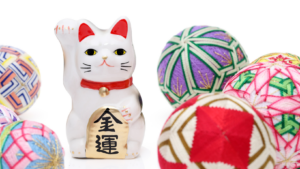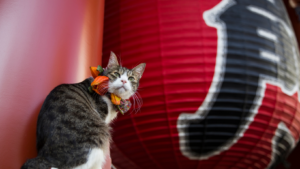Japanese cat art, a captivating blend of culture and creativity, has enchanted audiences for centuries. From ancient scrolls to modern manga, cats have prowled through Japan’s artistic landscape, embodying mystery, elegance, and playfulness. These feline figures are more than just muses; they’re symbols of good fortune and guardians against evil spirits in Japanese folklore.
In the Edo period, ukiyo-e artists like Utagawa Kuniyoshi immortalized cats in vibrant woodblock prints, capturing their whimsical antics and anthropomorphic charm. Today, the fascination continues with contemporary artists reimagining these creatures in various mediums. This enduring allure of cats in Japanese art reflects a deep cultural appreciation for their enigmatic nature and independent spirit.
Japanese Cat Art

Japanese cat art has a storied history rooted in symbolism and cultural significance. In the 9th century, cats arrived in Japan, initially serving as protectors of sacred texts from rodent damage. By the Heian period (794-1185), cats started to appear in art, reflecting their growing popularity among the aristocracy.
During the Edo period (1603-1868), the depiction of cats in art flourished. Ukiyo-e artists, most notably Utagawa Kuniyoshi, captured the essence of cats in woodblock prints. These artworks portrayed cats in various humorous and mystical contexts, blending reality with imagination. The playful expressions and vibrant colors attracted widespread attention, embedding cats into Japanese visual culture.
Influential Artists
Japanese cat art owes its development to numerous talented individuals who brought unique perspectives to this beloved subject.
Utagawa Kuniyoshi
Utagawa Kuniyoshi, a prominent ukiyo-e artist, made significant contributions to Japanese cat art during the Edo period. Known for his dynamic compositions, Kuniyoshi infused humor and imagination into his feline depictions. One famous piece, “Cats Suggested as the Fifty-three Stations of the Tōkaidō,” features cats in ways that mimic famous Tōkaidō locations, showcasing his ability to blend realism with fantasy. His creative approach inspired subsequent artists and enriched the visual language of cats in art.
Tsuguharu Foujita
Tsuguharu Foujita, renowned for his cat paintings, bridged Western and Eastern art styles in the early 20th century. His distinctive use of milky-white backgrounds and precise ink lines captured the elegance and playfulness of cats. In works like “Café in the Bois” or “Sleeping Cat,” Foujita’s focus on detail and texture highlighted his Western training while maintaining a distinctly Japanese aesthetic. His contributions extended the reach of Japanese cat art beyond its borders, influencing global perceptions.
Artistic Styles And Techniques
Japanese cat art showcases distinct artistic styles that highlight the elegance and charm of cats. Traditional and modern techniques contribute to this unique genre.
Woodblock Prints

Woodblock prints, particularly during the Edo period, played a significant role in Japanese cat art. Ukiyo-e artists, like Utagawa Kuniyoshi, utilized intricate carving techniques and vibrant colors to capture cats’ playful nature. These prints often depicted cats in everyday scenes or mythical settings, combining realism with imaginative elements. The repetitive process of carving and printing allowed artists to produce detailed and expressive feline images, contributing to the widespread popularity of cat-themed woodblock art.
Ink And Wash Drawings
Ink and wash drawings are characterized by their fluidity and expressiveness. In Japanese cat art, these techniques emphasized the elegance and spontaneity of feline forms. Artists used brush strokes of varying intensity to convey texture and movement, capturing the nuance of cats’ behavior. Tsuguharu Foujita’s cat paintings exemplified ink precision, blending Eastern and Western influences. His work highlighted the gracefulness of cats, using minimal lines and subtle washes to evoke a sense of serenity and refinement. This approach continues to influence contemporary artists globally, expanding the reach of Japanese cat art.
Symbolism In Japanese Cat Art

Japanese cat art carries rich symbolism, reflecting deep cultural beliefs and values. Cats often represent good fortune and prosperity. In the Edo period, they appeared in talismans known as “maneki-neko,” or beckoning cats, which are believed to attract wealth and luck. These figurines, often with a raised paw, symbolize the invitation of positive energy into homes and businesses.
Cats in Japanese art symbolize protection and warding off evil spirits. Their presence in homes and temples historically served as guardians against negative forces and misfortune. Artists depicted cats in paintings, emphasizing their role as mythical protectors.



